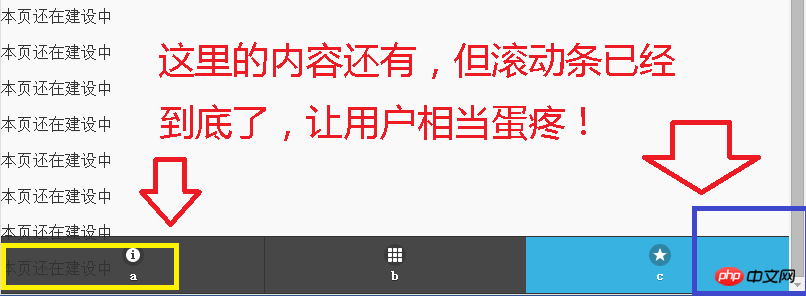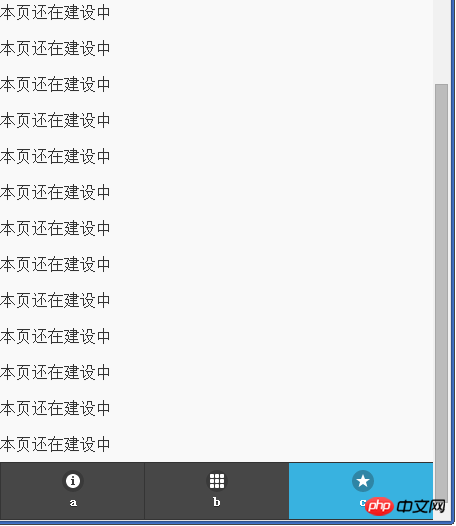How to solve jQuery Mobile form long content defect
This article mainly introduces the shortcomings and solutions of jQueryMobile's long form content. It analyzes the solution when the bottom floating layer of jQueryMobile is blocked by using specific examples. It is very simple and practical. Friends who need it can refer to it. I hope it can Help everyone.
Once long content appears in the form, there are flaws in using the author's full-screen layout with fixed header and footer.

As shown in the figure, The last content of the long content cannot be exhausted until the scroll bar is pulled to the bottom.
And it is very likely that although the content in this place is now displayed as translucent, there are often some submit buttons or something like this.
Users can’t click at all,
Therefore, improvements need to be made to replace the content in the original code:
<!DOCTYPE html PUBLIC "-//W3C//DTD XHTML 1.0 Transitional//EN" "http://www.w3.org/TR/xhtml1/DTD/xhtml1-transitional.dtd">
<html xmlns="http://www.w3.org/1999/xhtml">
<head>
<meta http-equiv="Content-Type" content="text/html; charset=utf-8" />
<title>a</title>
<meta name="viewport" content="width=device-width,initial-scale=1.0,user-scalable=no">
<link rel="stylesheet" href="jqmobile/jquery.mobile-1.4.5.css" rel="external nofollow" rel="external nofollow" >
<script src="jqmobile/jquery-1.11.1.js"></script>
<script src="jqmobile/jquery.mobile-1.4.5.js"></script>
</head>
<body>
<p data-role="page" data-position="fixed" data-fullscreen="true">
<p data-role="header" data-theme="b" data-tap-toggle = "false">
<h1>title</h1>
</p>
<p data-role="content">
<p>本页还在建设中</p><p>本页还在建设中</p><p>本页还在建设中</p><p>本页还在建设中</p><p>本页还在建设中</p><p>本页还在建设中</p><p>本页还在建设中</p><p>本页还在建设中</p><p>本页还在建设中</p><p>本页还在建设中</p><p>本页还在建设中</p><p>本页还在建设中</p><p>本页还在建设中</p><p>本页还在建设中</p><p>本页还在建设中</p>
</p>
<p data-role="footer" data-position="fixed" data-fullscreen="true" data-theme="b" data-tap-toggle = "false">
<p data-role="navbar">
<ul>
<li><a href="a.html" rel="external nofollow" rel="external nofollow" target="_self" data-icon="info">a</a></li>
<li><a href="b.html" rel="external nofollow" rel="external nofollow" target="_self" data-icon="grid">b</a></li>
<li><a href="#" rel="external nofollow" rel="external nofollow" class="ui-btn-active ui-state-persist" data-icon="star">c</a></li>
</ul>
</p>
</p>
</p>
</body>
</html>Add a style to the layer, style="margin-bottom:50px", which becomes:
<!DOCTYPE html PUBLIC "-//W3C//DTD XHTML 1.0 Transitional//EN" "http://www.w3.org/TR/xhtml1/DTD/xhtml1-transitional.dtd">
<html xmlns="http://www.w3.org/1999/xhtml">
<head>
<meta http-equiv="Content-Type" content="text/html; charset=utf-8" />
<title>a</title>
<meta name="viewport" content="width=device-width,initial-scale=1.0,user-scalable=no">
<link rel="stylesheet" href="jqmobile/jquery.mobile-1.4.5.css" rel="external nofollow" rel="external nofollow" >
<script src="jqmobile/jquery-1.11.1.js"></script>
<script src="jqmobile/jquery.mobile-1.4.5.js"></script>
</head>
<body>
<p data-role="page" data-position="fixed" data-fullscreen="true">
<p data-role="header" data-theme="b" data-tap-toggle = "false">
<h1>title</h1>
</p>
<p data-role="content" style="margin-bottom:50px">
<p>本页还在建设中</p><p>本页还在建设中</p><p>本页还在建设中</p><p>本页还在建设中</p><p>本页还在建设中</p><p>本页还在建设中</p><p>本页还在建设中</p><p>本页还在建设中</p><p>本页还在建设中</p><p>本页还在建设中</p><p>本页还在建设中</p><p>本页还在建设中</p><p>本页还在建设中</p><p>本页还在建设中</p><p>本页还在建设中</p>
</p>
<p data-role="footer" data-position="fixed" data-fullscreen="true" data-theme="b" data-tap-toggle = "false">
<p data-role="navbar">
<ul>
<li><a href="a.html" rel="external nofollow" rel="external nofollow" target="_self" data-icon="info">a</a></li>
<li><a href="b.html" rel="external nofollow" rel="external nofollow" target="_self" data-icon="grid">b</a></li>
<li><a href="#" rel="external nofollow" rel="external nofollow" class="ui-btn-active ui-state-persist" data-icon="star">c</a></li>
</ul>
</p>
</p>
</p>
</body>
</html>, then the page can be exhausted, as shown in the figure below:

Related recommendations:
Recommended 3 articles about getting started with Mobile
Jquery_mobile for WeChat development microsite Case analysis
jQuery-mobile event monitoring and usage details
The above is the detailed content of How to solve jQuery Mobile form long content defect. For more information, please follow other related articles on the PHP Chinese website!

Hot AI Tools

Undresser.AI Undress
AI-powered app for creating realistic nude photos

AI Clothes Remover
Online AI tool for removing clothes from photos.

Undress AI Tool
Undress images for free

Clothoff.io
AI clothes remover

Video Face Swap
Swap faces in any video effortlessly with our completely free AI face swap tool!

Hot Article

Hot Tools

Notepad++7.3.1
Easy-to-use and free code editor

SublimeText3 Chinese version
Chinese version, very easy to use

Zend Studio 13.0.1
Powerful PHP integrated development environment

Dreamweaver CS6
Visual web development tools

SublimeText3 Mac version
God-level code editing software (SublimeText3)

Hot Topics
 1386
1386
 52
52
 Detailed explanation of jQuery reference methods: Quick start guide
Feb 27, 2024 pm 06:45 PM
Detailed explanation of jQuery reference methods: Quick start guide
Feb 27, 2024 pm 06:45 PM
Detailed explanation of jQuery reference method: Quick start guide jQuery is a popular JavaScript library that is widely used in website development. It simplifies JavaScript programming and provides developers with rich functions and features. This article will introduce jQuery's reference method in detail and provide specific code examples to help readers get started quickly. Introducing jQuery First, we need to introduce the jQuery library into the HTML file. It can be introduced through a CDN link or downloaded
 How to use PUT request method in jQuery?
Feb 28, 2024 pm 03:12 PM
How to use PUT request method in jQuery?
Feb 28, 2024 pm 03:12 PM
How to use PUT request method in jQuery? In jQuery, the method of sending a PUT request is similar to sending other types of requests, but you need to pay attention to some details and parameter settings. PUT requests are typically used to update resources, such as updating data in a database or updating files on the server. The following is a specific code example using the PUT request method in jQuery. First, make sure you include the jQuery library file, then you can send a PUT request via: $.ajax({u
 How to remove the height attribute of an element with jQuery?
Feb 28, 2024 am 08:39 AM
How to remove the height attribute of an element with jQuery?
Feb 28, 2024 am 08:39 AM
How to remove the height attribute of an element with jQuery? In front-end development, we often encounter the need to manipulate the height attributes of elements. Sometimes, we may need to dynamically change the height of an element, and sometimes we need to remove the height attribute of an element. This article will introduce how to use jQuery to remove the height attribute of an element and provide specific code examples. Before using jQuery to operate the height attribute, we first need to understand the height attribute in CSS. The height attribute is used to set the height of an element
 jQuery Tips: Quickly modify the text of all a tags on the page
Feb 28, 2024 pm 09:06 PM
jQuery Tips: Quickly modify the text of all a tags on the page
Feb 28, 2024 pm 09:06 PM
Title: jQuery Tips: Quickly modify the text of all a tags on the page In web development, we often need to modify and operate elements on the page. When using jQuery, sometimes you need to modify the text content of all a tags in the page at once, which can save time and energy. The following will introduce how to use jQuery to quickly modify the text of all a tags on the page, and give specific code examples. First, we need to introduce the jQuery library file and ensure that the following code is introduced into the page: <
 Yaber T2 (Plus): Compact projector with Full HD resolution, battery, JBL sound and smart functions
Jun 27, 2024 am 10:31 AM
Yaber T2 (Plus): Compact projector with Full HD resolution, battery, JBL sound and smart functions
Jun 27, 2024 am 10:31 AM
Yaber products are available on Amazon, and now the company offers a new projector - Yaber T2. The model is available in two versions: the Yaber T2 and the Yaber T2 Plus. The Yaber T2 Plus costs 349 dollars instead of 299 dollars and comes with a TV
 Use jQuery to modify the text content of all a tags
Feb 28, 2024 pm 05:42 PM
Use jQuery to modify the text content of all a tags
Feb 28, 2024 pm 05:42 PM
Title: Use jQuery to modify the text content of all a tags. jQuery is a popular JavaScript library that is widely used to handle DOM operations. In web development, we often encounter the need to modify the text content of the link tag (a tag) on the page. This article will explain how to use jQuery to achieve this goal, and provide specific code examples. First, we need to introduce the jQuery library into the page. Add the following code in the HTML file:
 The ultimate solution to JavaScript:void defect
Apr 09, 2024 pm 01:15 PM
The ultimate solution to JavaScript:void defect
Apr 09, 2024 pm 01:15 PM
The void operator in JavaScript has unexpected behavior and bugs that interfere with type inference. Alternative solutions include: 1. Use undefined to clearly express intent; 2. Use null to indicate that the value does not exist; 3. Use the ternary operator to concisely specify the value for different situations.
 How to tell if a jQuery element has a specific attribute?
Feb 29, 2024 am 09:03 AM
How to tell if a jQuery element has a specific attribute?
Feb 29, 2024 am 09:03 AM
How to tell if a jQuery element has a specific attribute? When using jQuery to operate DOM elements, you often encounter situations where you need to determine whether an element has a specific attribute. In this case, we can easily implement this function with the help of the methods provided by jQuery. The following will introduce two commonly used methods to determine whether a jQuery element has specific attributes, and attach specific code examples. Method 1: Use the attr() method and typeof operator // to determine whether the element has a specific attribute




